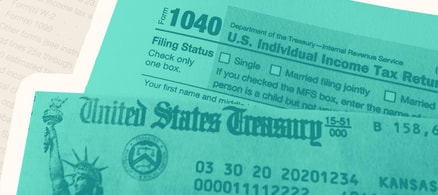Home office deduction
If you have a home office or a dedicated space where you run your business, you can deduct a portion of your housing from your taxes. To qualify, your home office must meet two criteria:
-
You must use your home office regularly and exclusively for your business. It can’t be a multi-purpose room like your kitchen or a family room.
-
It must be your principal place of business. You have to use this space to conduct business including meetings and doing tasks beyond checking your inbox.
If your home office meets the IRS’ requirements, there are a couple of different ways to calculate your deduction.
How to claim your home office on your taxes
The simplified option requires you to multiply the square footage of your home office by $5. This is the standard deduction amount provided by the IRS. You can deduct up to 300 square feet on your tax return for a maximum deduction of $1,500.
The other method is to deduct the actual amount of space your home office takes up. You can do this by calculating your home office as a percentage of your total home size. Measure your home office and divide it by your home’s square footage.
For example, if you have a 1,200-square-foot home and a 300-square-foot office then your home office would occupy 25% of your home. This means you could deduct 25% of your home’s allowable expenses.
A home office deduction is not just limited to your mortgage or rent. You can also deduct other related expenses like utilities, maintenance, and in some cases, property taxes. Allowable deductions are itemized on a Schedule A and have to be backed up by meticulous recordkeeping. While the simple deduction is easier, a calculated deduction could lead to much larger savings on your total tax bill.
Working from home? Read our guide on tax implications when working remotely.
Credit card and loan interest
The interest generated by credit cards and loans used to support your business can be deducted from your taxes. According to the IRS, purchases you make that contribute to your business’s operations may be eligible for a deduction. This can include things like internet, wages, rent, and loan interest.
When your business is just getting started you might rely heavily on high-interest financing from credit cards. Taking an interest deduction can help reduce your overall tax bill.
If you’re self-employed and don’t have a business credit card you are still eligible for this deduction. A personal card used exclusively for business expenses can qualify for the interest deduction too.
Note: Interest accrued from personal purchases is not tax deductible. You’ll want to make sure to keep personal expenses separate from business expenses.
Training and education
Education is not only important but oftentimes essential for you to grow your business. You need to constantly learn new skills to be able to provide quality services to your clients and customers.
Educational expenses incurred to help you obtain new skills related to your line of work may be eligible for a deduction. This can include expenses like tuition or course fees, books, and related supplies. If you commute to and from a physical classroom, your mileage may also be deductible too. This brings us to our next deduction.
Business mileage
Depending on your line of work, you may be required to use your personal vehicle for business-related activities. If you drive to client sites for meetings, make deliveries, or travel locally for your business, you can deduct the mileage from your taxes.
To qualify for the business mileage deduction, you must meet the following requirements:
- You own or lease your vehicle
- You operate less than five vehicles at a time
- You are not claiming depreciation on your vehicles
For 2023, the standard mileage rate is 65.5 cents per mile, up from 62.5 cents per mile in the second half of 2022. To maximize your advantages, it's important that you maintain good records of how you use your car for business-related activities. Keep a log of your business miles to keep them separate from personal trips.
Health insurance premiums
One challenge of self-employment is not qualifying for an employer’s health care plan. You’ll have to pay for your own insurance either directly with a company or through your state’s healthcare marketplace.
As a self-employed person, your health insurance premium may be eligible for a deduction. This can include the premium you pay for yourself, your spouse, and any dependents or children under age 27 who are on your health plan, even if you don’t claim them on your tax return.
Cell phone and internet bills
If you work for yourself, there’s a good chance you use your phone and internet for business activities. This makes a portion of your phone and internet bill deductible.
Determine how often you use your phone and internet to conduct business activities versus for personal use. If 25% of your usage is allocated to business activities then you can deduct 25% of your bill for business expenses.
If you have a separate business phone and business internet package for your home office you may not be able to deduct your personal phone or regular home internet as a business expense.
Self-employment taxes
Individuals who work for themselves have to pay an additional self-employment tax of 15.3%. Of this, 12.4% is allocated to Social Security while the remaining 2.9% goes to Medicare. These taxes are usually covered on your behalf by your employer. Because you don’t have an employer you are responsible for paying these taxes yourself.
The self-employment tax is assessed on your net earnings, not your gross revenue. You can calculate your net earnings by deducting your business expenses from your business income. If your net earnings come to $100,000 this year then your self-employment tax is $15,300.
The IRS allows you to deduct the employer portion of the taxes collected for Medicare and Social Security. This equates to deducting 50% of your self-employment taxes on your tax return.
For 2023 the IRS assesses a self-employment tax on earnings up to $160,200. After that, no additional self-employment taxes are assessed.
More: Top tips for freelancers to handle personal saving and investing
Club and membership dues
Your line of business may require you to be a member of a club or trade organization. The purpose of the club can’t be solely for the entertainment of members. It must have a business purpose.
Examples of clubs or memberships that qualify include:
- Membership in your local chamber of commerce
- Participation in a trade association
- Admission to a local real estate board
- Professional organizations like a medical board or bar association
Retirement savings
Self-employed individuals can make retirement contributions to a qualified tax-deferred plan like a 401(k) or SEP IRA. This allows individuals to benefit from investing pre-tax dollars just like regular W-2 employees.
For the 2023 tax season, the IRS allows individuals to contribute up to $22,500 in a 401(k). Self-employed individuals can contribute an additional 25% of their net earnings for a total contribution of $66,000. Individuals contributing to a SIMPLE IRA can save up to $15,500 in 2023 with an additional 2% fixed contribution or a 3% match.
A tax-deferred contribution is, well, tax-deferred, and therefore not deductible on your taxes. However, it can reduce your overall adjusted gross income and thus the tax bracket you fall in. Depending on your earnings, moving into a lower tax bracket can translate into significant savings.
More: 5 best types of tax-deferred accounts
Start-up costs
When you start your own business you can include start-up costs as a deduction. This can include the cost of acquiring a business or the fees you have to pay to register a corporation or partnership.
The IRS allows you to deduct up to $5,000 in business start-up costs and up to $5,000 in organizational costs.
The takeaway: it pays to be savvy with your deductions (in more ways than one!)
Being self-employed is a great way to find work-life balance but it does come with some trade-offs. For one, self-employed individuals don't get employee-covered health insurance premiums, taxes for Medicare and Social Security, and matching retirement contributions.
The good news is that there are a number of deductions that self-employed individuals can take to reduce their taxable income. Individuals looking to benefit from these deductions should always keep good records that demonstrate work-related expenses that are separate from personal expenses.
These deductions also allow you to invest in yourself, which may be the ultimate benefit of self-employment.
More tax guides >>>








